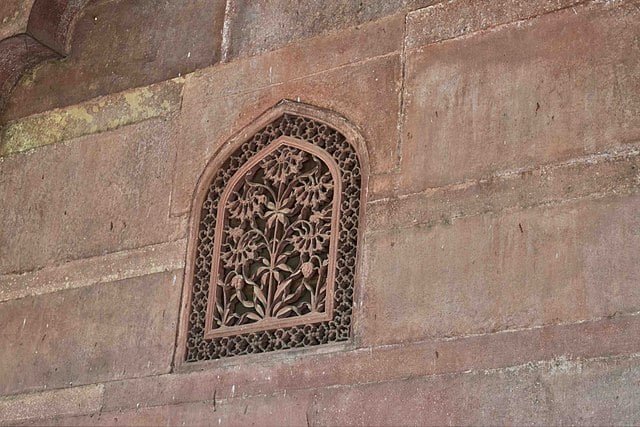Red Fort, also known as Lal Qila is a historic fort in the Old Delhi neighbourhood of Delhi, India, that historically served as the main residence of the Mughal emperors. Emperor Shah Jahan commissioned construction of the Red Fort on 12th May 1638, when he decided to shift his capital from Agra to Delhi.
Originally red and white, its design is credited to architect Ustad Ahmad Lahori, who also constructed the Taj Mahal. Red fort represents the peak in Mughal architecture under Shah Jahan and combines Persianate palace architecture with Indian traditions. The fort was plundered of its artwork and jewels during Nader Shah’s invasion of the Mughal Empire in 1739. Most of the fort’s marble structures were subsequently demolished by the British following the Indian Rebellion of 1857. Visit during Delhi Local sightseeing by cab
The fort’s defensive walls were largely undamaged, and the fortress was subsequently used as a garrison. On 15th August 1947, the first prime minister of India, Jawaharlal Nehru, raised the Indian flag above the Lahori Gate. Every year on India’s Independence Day (15th August), the prime minister hoists the Indian tricolour flag at the fort’s main gate and delivers a nationally broadcast speech from its ramparts.
The Red Fort was designated a UNESCO World Heritage Site in 2007 as part of the Red Fort Complex. In this article, we will explore the history, features and significance of Red Fort Delhi, as well as provide some practical information for visitors.
Location of Red Fort

Red Fort is situated in the heart of Old Delhi, on the Netaji Subhash Marg. It is easily accessible by road and public transport. The nearest airport is Indira Gandhi International Airport, which is about 20 km away. The nearest railway station is New Delhi Railway Station, which is about 4 km away. The nearest metro station is Chandni Chowk Metro Station, which is about 1 km away.
Timing / Entry Fees
Red Fort is open to visitors from Tuesday to Sunday from 9:30 am to 4:30 pm. It remains closed on Mondays and public holidays. The entry fee for Indian citizens is Rs. 35 per person, while for foreign nationals it is Rs. 500 per person. There is no entry fee for children below the age of 15. There is also a separate fee for camera and video recording.
How to Reach

There are various modes of transport available to reach Red Fort from Delhi city. You can take a bus, auto-rickshaw, taxi or car to reach the fort. The bus fare is around Rs. 10 per person, while the auto-rickshaw fare is around Rs. 50-100 depending on the distance and bargaining. The taxi or car fare may vary depending on the service provider and traffic conditions.
Things to Do / Must See Red Fort

Red Fort is a magnificent monument that displays the Mughal architecture and art. It has a lot to offer to visitors who are interested in history, culture and heritage. Here are some of the things you can do and see at The Fort:
- Admire the impressive facade of The Fort, which has two entrances namely Delhi Gate and Lahori Gate.
- Explore the interior of The Fort, which has various buildings such as Diwan-i-Aam (Hall of Public Audience), Diwan-i-Khas (Hall of Private Audience), Rang Mahal (Palace of Colours), Moti Masjid (Pearl Mosque), Mumtaz Mahal (Jewel Palace), Khas Mahal (Private Palace) etc.
- Visit the museum, which displays various items such as paintings, coins, weapons, manuscripts etc. belonging to the Mughal period.
- Learn more about the history and significance of The Fort at the information boards and plaques installed in the fort.
- Enjoy the light and sound show that takes place every evening at Red Fort.
- Admire the statue of Mahatma Gandhi, which is located near Swatantra Sangram Sangrahalaya (Museum of Freedom Struggle).
History of Red Fort

Red Fort was built by Shah Jahan, the fifth Mughal emperor, who decided to shift his capital from Agra to Delhi in 1638. He commissioned the construction of Red Fort on 12th May 1638 and it was completed in 1648. The fort was named Qila-i-Mubarak (Blessed Fort) and served as the main residence of the Mughal emperors and their court. The fort was also the centre of administration and cultural activities of the Mughal empire.
The fort witnessed many events and changes in the Mughal history. It was attacked and plundered by Nader Shah, the Persian invader, in 1739, who looted the Peacock Throne and the Koh-i-Noor diamond from the fort. It was also captured by the Marathas in 1788 and later by the British in 1803. The fort became a symbol of resistance during the Indian Rebellion of 1857, when Bahadur Shah Zafar, the last Mughal emperor, was declared as the leader of the rebels. However, the rebellion was crushed by the British and Bahadur Shah Zafar was exiled to Rangoon. The British also destroyed many of the fort’s buildings and structures and used it as a military barracks.
After India gained independence in 1947, Red Fort became a national monument and a site of historical and political significance. On 15th August 1947, Jawaharlal Nehru, the first prime minister of India, hoisted the Indian flag at The Fort and delivered his famous “Tryst with Destiny” speech. Since then, every year on Independence Day, the prime minister hoists the flag at Red Fort and addresses the nation from its ramparts.
Significance of Red Fort

Red Fort is a significant monument for India for various reasons. It is a masterpiece of Mughal architecture and art that showcases the peak of Shah Jahan’s reign. It combines Persianate palace architecture with Indian traditions and influences. It is also a UNESCO World Heritage Site that represents the cultural and artistic heritage of India.
Red Fort is also a symbol of India’s freedom struggle and democracy. It is a place where many important events and movements took place that shaped India’s history and destiny. It is a place where India’s first prime minister hoisted the flag and announced India’s independence from British rule. It is a place where every year on Independence Day, the prime minister addresses the nation and reaffirms India’s commitment to democracy and development.
Red Fort is also a place of pride and honour for India. It is a place where India showcases its achievements and aspirations to the world. It is a place where India celebrates its diversity and unity as a nation. It is a place where India pays tribute to its martyrs and heroes who sacrificed their lives for India’s freedom and glory.
FAQ’s
Q: When was Red Fort built?
A: Red Fort was built between 1638 and 1648 by Shah Jahan.
Q: Who designed Red Fort?
A: The Fort was designed by Ustad Ahmad Lahori, who also designed Taj Mahal.
Q: What are the main attractions of Red Fort?
A: The main attractions of The Fort are Diwan-i-Aam (Hall of Public Audience), Diwan-i-Khas (Hall of Private Audience), Rang Mahal (Palace of Colours), Moti Masjid (Pearl Mosque), Mumtaz Mahal (Jewel Palace), Khas Mahal (Private Palace), Lahori Gate, Delhi Gate etc.
Q: What is the light and sound show at Red Fort?
A: The light and sound show at The Fort is a multimedia show that narrates the history and significance of Red Fort through lights, sounds and visuals. It takes place every evening at The Fort.
Q: How can I book tickets for Red Fort?
A: You can book tickets for The Fort online through ASI website or offline at Red Fort ticket counter.
Conclusion
Red Fort is a magnificent monument that reflects the glory and grandeur of Mughal empire. It is also a monument that represents India’s freedom struggle and democracy. It is a monument that showcases India’s cultural and artistic heritage. It is a monument that celebrates India’s diversity and unity as a nation. Red Fort is a monument that every Indian should visit at least once in their lifetime.











Comments are closed.